Capacitor Charge & Discharge Equations (OCR A Level Physics)
Revision Note
The Time Constant
The time constant of a capacitor discharging through a resistor is a measure of how long it takes for the capacitor to discharge
The definition of the time constant is:
The time taken for the charge, current or voltage of a discharging capacitor to decrease to 37% of its original value
Alternatively, for a charging capacitor:
The time taken for the charge or voltage of a charging capacitor to rise to 63% of its maximum value
37% is 0.37 or
(where e is the exponential function) multiplied by the original value (I0, Q0 or V0)
This is represented by the Greek letter tau,
, and measured in units of seconds (s)
The time constant provides an easy way to compare the rate of change of similar quantities eg. charge, current and p.d.
It is defined by the equation:
= RC
Where:
= time constant (s)
R = resistance of the resistor (Ω)
C = capacitance of the capacitor (F)
The time to half, t1/2 (half-life) for a discharging capacitor is:
The time taken for the charge, current or voltage of a discharging capacitor to reach half of its initial value
This can also be written in terms of the time constant, τ:
t1/2 = ln(2) ≈ 0.69
= 0.69RC
Worked Example
A capacitor of 7 nF is discharged through a resistor of resistance, R. The time constant of the discharge is 5.6 × 10−3 s.
Calculate the value of R.
Answer:
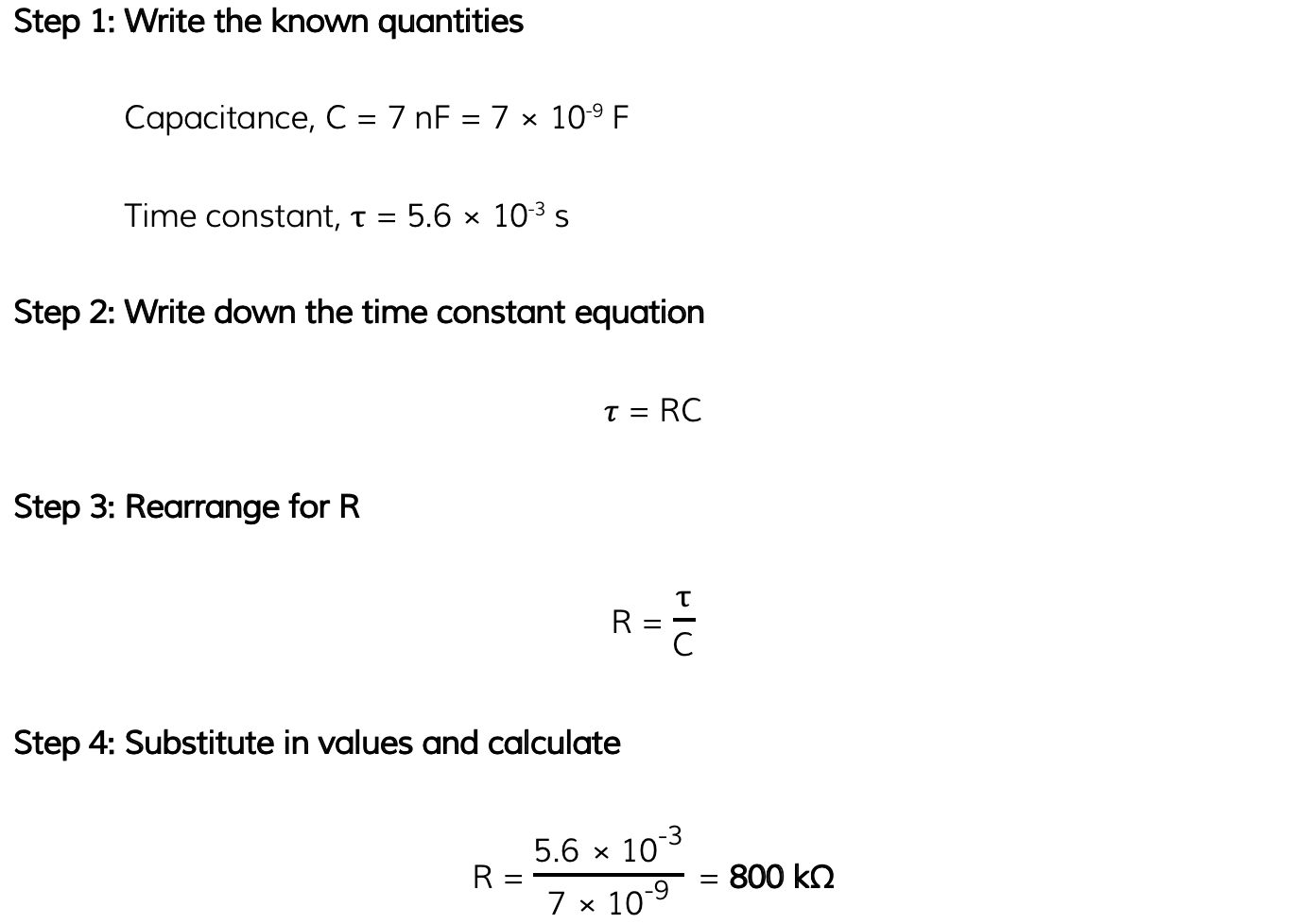
Examiner Tips and Tricks
Note that the time constant is not the same as half-life. Half-life is how long it takes for the current, charge or voltage to halve whilst the time constant is to 37% of its original value (not 50%).
Although the time constant is given on the datasheet, you will be expected to remember the half-life equation t1/2 = 0.69RC
Charging & Discharging Equations
The time constant is used in the exponential decay equations for the current, charge or potential difference (p.d.) for a capacitor charging, or discharging, through a resistor
These equations can be used to determine:
The amount of current, charge or p.d. gained after a certain amount of time for a charging capacitor
The amount of current, charge or p.d. remaining after a certain amount of time for a discharging capacitor
Capacitor Discharge Equations
This exponential decay means that no matter how much charge is initially on the plates, the amount of time it takes for that charge to halve is the same
The exponential decay of current on a discharging capacitor is defined by the equation:

Where:
I = current (A)
I0 = initial current before discharge (A)
e = the exponential function
t = time (s)
RC = resistance (Ω) × capacitance (F) = the time constant τ (s)
This equation shows that the smaller the time constant τ, the quicker the exponential decay of the current when discharging
Also, how big the initial current is affects the rate of discharge
If I0 is large, the capacitor will take longer to discharge
Note: during capacitor discharge, I0 is always larger than I, as the current I will always be decreasing
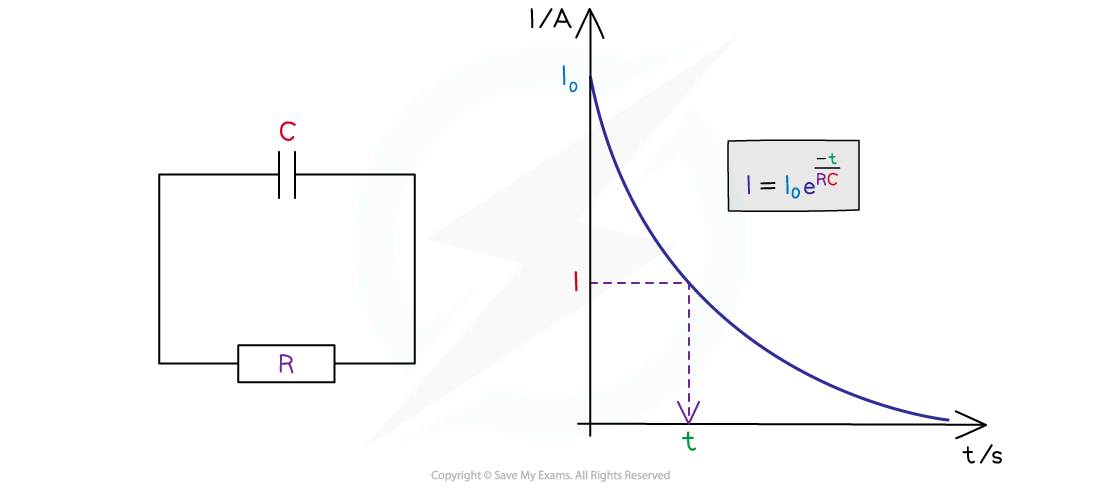
Values of the capacitor discharge equation on a graph and circuit
The current at any time is directly proportional to the p.d. across the capacitor and the charge across the parallel plates
Therefore, this equation also describes the charge on the capacitor after a certain amount of time:

Where:
Q = charge on the capacitor plates (C)
Q0 = initial charge on the capacitor plates (C)
As well as the p.d. after a certain amount of time:

Where:
V = p.d. across the capacitor (C)
V0 = initial p.d. across the capacitor (C)
Worked Example
The initial current through a circuit with a capacitor of 620 µF is 0.6 A. The capacitor is connected across the terminals of a 450 Ω resistor.
Calculate the time taken for the current to fall to 0.4 A.
Answer:
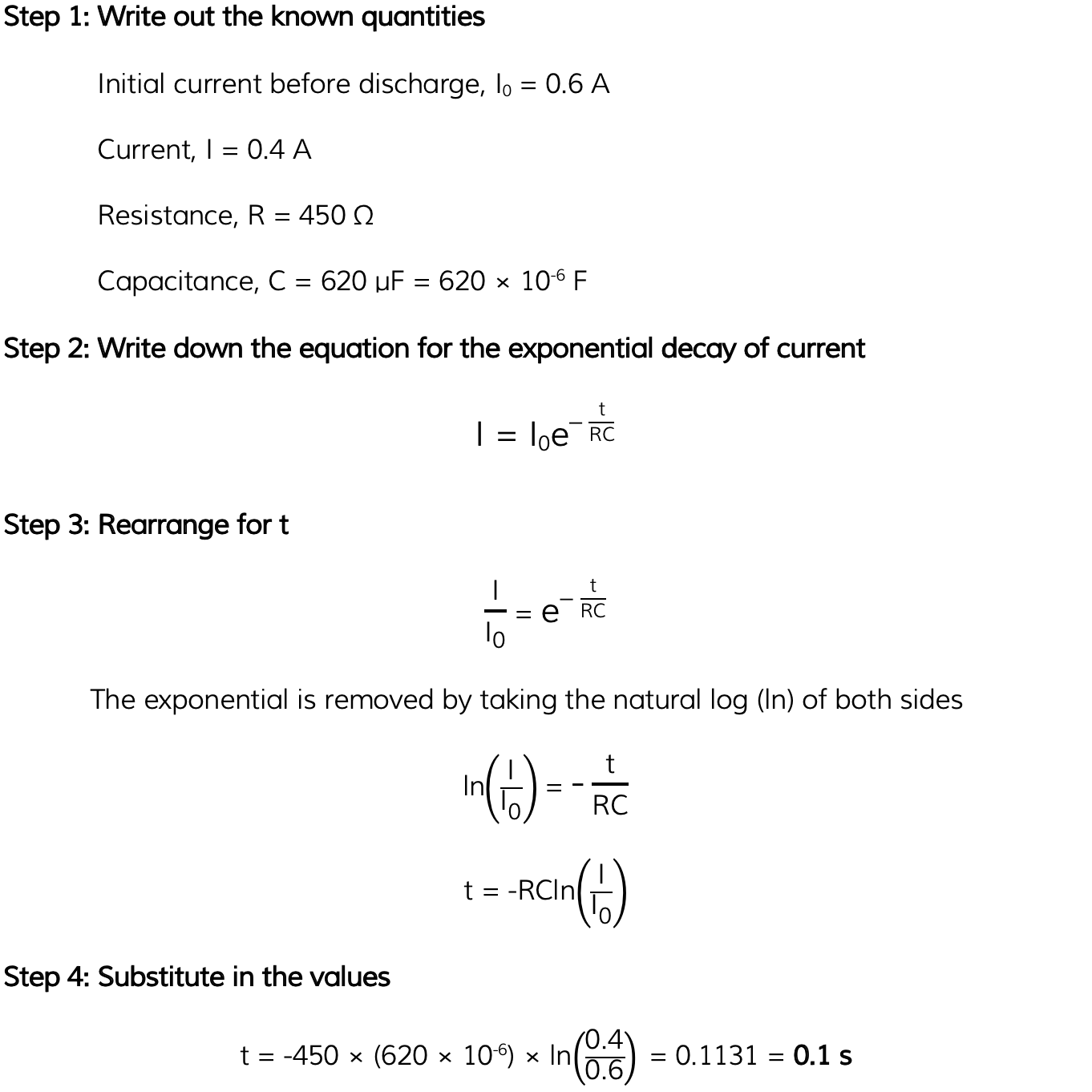
Capacitor Charge Equations
When a capacitor is charging, the way the charge Q and potential difference V increases stills shows exponential decay
Over time, they continue to increase but at a slower rate
This means the equation for Q for a charging capacitor is:

Where:
Q = charge on the capacitor plates (C)
Q0 = maximum charge stored on capacitor when fully charged (C)
e = the exponential function
t = time (s)
RC = resistance (Ω) × capacitance (F) = the time constant τ (s)
Similarly, for V:

Where:
V = p.d. across the capacitor (V)
V0 = maximum potential difference across the capacitor when fully charged (V)
The charging equation for the current I is the same as its discharging equation since the current still decreases exponentially
The key difference with the charging equations is that Q0 and V0 are now the final (or maximum) values of Q and V that will be on the plates, rather than the initial values
Worked Example
A capacitor is to be charged to a maximum potential difference of 12 V between its plate.
Calculate how long it takes to reach a potential difference 10 V given that it has a time constant of 0.5 s.
Answer:
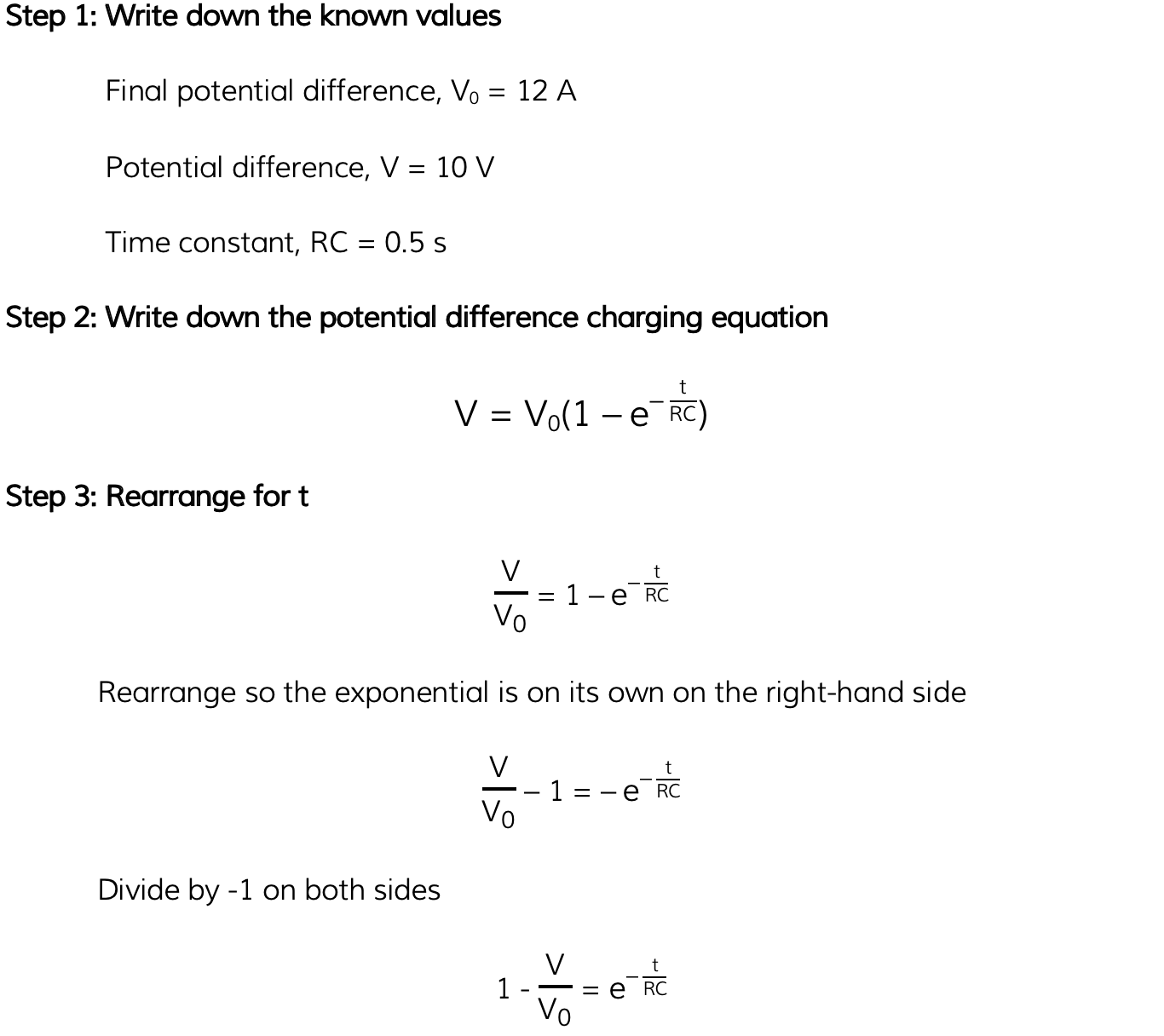
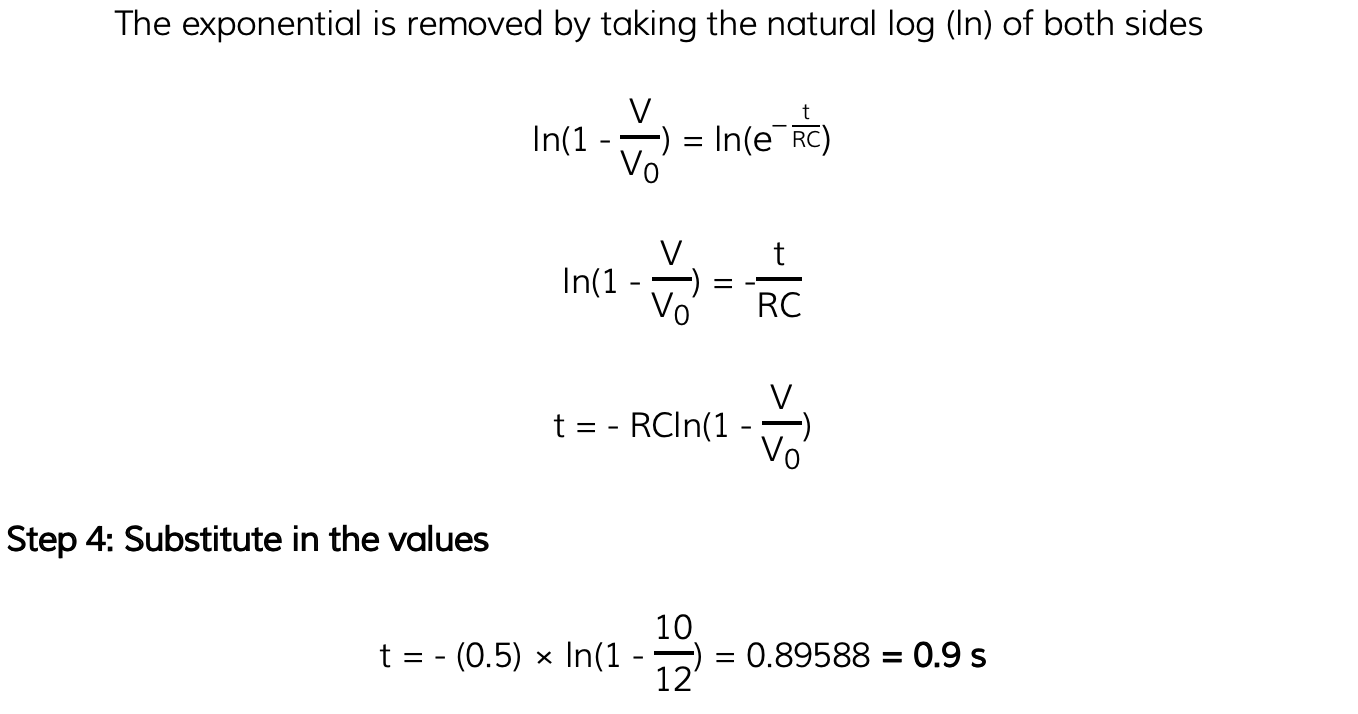
Examiner Tips and Tricks
Knowledge of the exponential constant, a number which is approximately equal to e = 2.718..., is crucial for mastering charge and discharge equations, so make sure you know how to use it:
On a calculator, it is shown by the button ex
The inverse function of ex is ln(y), known as the natural logarithmic function
This is because, if ex = y, then x = ln (y)
The 0.37 in the definition of the time constant arises as a result of the exponential constant, so make sure you know that the true definition is:
Time constant = The time taken for the charge of a capacitor to decrease to of its original value
Where = 0.3678

You've read 0 of your 5 free revision notes this week
Sign up now. It’s free!
Did this page help you?
